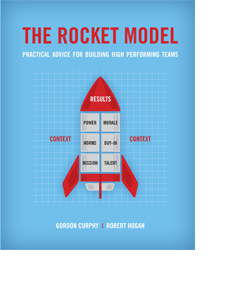There is no universally accepted model for transforming collections of individuals into high performing teams. There are four more common models used to improve team performance, which include Tuckman’s Stage Model, Hackman’s Inputs-Processes-Outputs Model, Lencioni’s Five Dysfunctions of a Team, and Curphy and Hogan’s Rocket Model. Although each of these frameworks offers unique insights into team dynamics, The Rocket Model has several distinct advantages over the others.

Models of Team Performance
Tuckman’s Stage Model. Tuckman noted that leaderless discussion groups seemed to go through four distinct phases: forming, storming, norming, and performing. Groups do not become highly effective until they reach the performing stage. The model provides advice to leaders for helping groups transition through the four phases. Although these phases can readily be seen in volunteer groups, they rarely occur in corporate settings since work groups are usually brought together for some purpose, have better defined roles, and have some sort of pecking order.
Hackman’s Inputs-Processes-Outputs Model. According to Hackman, inputs are the raw materials available to a group or team, and include team members, raw materials, equipment, etc. Processes are the procedures or systems team members use to do work, and outputs are the end products. The inputs-processes-outputs model is based on sound research, but is too vague to be of much use.
Lencioni’s Five Dysfunctions of a Team. Lencioni developed a team performance stage model that includes: (a) absence of trust; (b) fear of conflict; (c) lack of commitment; (d) avoidance of accountability; and (e) inattention to results. The model provides some useful insights into team dynamics, but is not based on sound research, and although it seems to make intuitive sense, in many cases it is simply wrong.
Curphy and Hogan’s Rocket Model. The Rocket Model capitalizes on the advantages of the previous frameworks in that it is based on research from hundreds of teams and provides sound, practical advice for improving group and team performance. The Rocket Model consists of eight components, which include context, mission, talent, norms, buy-in, power, morale, and results. Context concerns gaining team member agreement on the challenges facing the team; mission is setting team goals and benchmarks; talent focuses on the number, roles, and skills of team members; norms pertain to the rules by which team members operate; buy-in is all about fostering employee engagement; power concerns acquiring needed authority and resources; morale pertains to the level of team esprit-de-corps and conflict, and the accomplishments attained fall in to the results component.
The Rocket Model can be used to diagnose current team functioning and launch brand new teams. It can also be applied to co-located and virtual teams and groups. Because it is based on a foundation of research and provides practical advice for improving group and team performance, we believe The Rocket Model is superior to the other three frameworks.
By Gordon Curphy
Curphy Consulting Corporation
Guest blogger and author of The Rocket Model